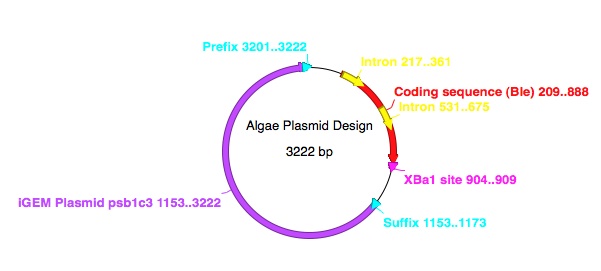Team:UEA-JIC Norwich/Nittygritty-algae
From 2011.igem.org
| Line 12: | Line 12: | ||
<body> | <body> | ||
| - | <h1><p style="background- color: | + | <h1><p style=""background-color:#000000">Algae</h1> |
<p>We are planning to transform the algal species <i>Chlamydomonas reinhardtii</i>. This is a single celled, photosynthetic eukaryote. It is easily transformable, either by: electroporation; the bacterium Agrobacterium tumorfaciens; glass beads; or by the use of a biolistic particle delivery system (gene gun). We will be using the specific strain CC-4350 cw15-302 mt+. This strain is biflagellate with a high transformation frequency, due in part to its lack of a cell wall. Its genome has been sequenced, allowing us to research its codon bias.</p> | <p>We are planning to transform the algal species <i>Chlamydomonas reinhardtii</i>. This is a single celled, photosynthetic eukaryote. It is easily transformable, either by: electroporation; the bacterium Agrobacterium tumorfaciens; glass beads; or by the use of a biolistic particle delivery system (gene gun). We will be using the specific strain CC-4350 cw15-302 mt+. This strain is biflagellate with a high transformation frequency, due in part to its lack of a cell wall. Its genome has been sequenced, allowing us to research its codon bias.</p> | ||
<p>There are twenty common amino acids, but over sixty codon configurations. So, each amino acid can be coded for by multiple codons. The code is thus said to be degenerate. However, most organisms display a preference for one codon or another, and so prefer to express a given amino acid by a certain codon. This is known as the codon bias. We researched the codon bias for <i>Chlamydomonas reinhardtii</i>, and plan to use this information to optimise the Biobricks we wish to use for expression in <i>C. reinhardtii</i>. | <p>There are twenty common amino acids, but over sixty codon configurations. So, each amino acid can be coded for by multiple codons. The code is thus said to be degenerate. However, most organisms display a preference for one codon or another, and so prefer to express a given amino acid by a certain codon. This is known as the codon bias. We researched the codon bias for <i>Chlamydomonas reinhardtii</i>, and plan to use this information to optimise the Biobricks we wish to use for expression in <i>C. reinhardtii</i>. | ||
Revision as of 13:24, 29 July 2011
Algae
We are planning to transform the algal species Chlamydomonas reinhardtii. This is a single celled, photosynthetic eukaryote. It is easily transformable, either by: electroporation; the bacterium Agrobacterium tumorfaciens; glass beads; or by the use of a biolistic particle delivery system (gene gun). We will be using the specific strain CC-4350 cw15-302 mt+. This strain is biflagellate with a high transformation frequency, due in part to its lack of a cell wall. Its genome has been sequenced, allowing us to research its codon bias.
There are twenty common amino acids, but over sixty codon configurations. So, each amino acid can be coded for by multiple codons. The code is thus said to be degenerate. However, most organisms display a preference for one codon or another, and so prefer to express a given amino acid by a certain codon. This is known as the codon bias. We researched the codon bias for Chlamydomonas reinhardtii, and plan to use this information to optimise the Biobricks we wish to use for expression in C. reinhardtii.
Below is the plasmid we designed for the algal construct. We used the Ble gene conferring the Bleomycin resistance cassette for the selection marker. This confers resistance to the Bleomycin family of antibiotics (we used phleomycin to select our transformed cells). One other option we considered was selection by Arginine, but this would narrow down the range of possible algal species future iGEM teams could use, as a strain with a mutated Arginine Biosynthesis gene would have to be used.

The Ble gene we used came from the Chlamydomonas Centre (USA). This gene has been adapted for use in eukaryotic organisms, including the insertion of two introns (see above) and the addition of a 5' and 3' untranslated region (UTR). We used PCR (polymerase chain reaction) to extract the gene from the plasmid it came in, simultaneously adding the iGEm prefix and suffix to either end. We encountered difficulties in using the Ble gene, in that it contained an illegal Xba1 site in the 3' UTR. Adhering to the Biobrick assembly standards was very important to us, as we wished to make the accessibility of these two species as easy as possible for future teams. Therefore we plan to use site directed mutagenesis to remove this site.
 "
"




